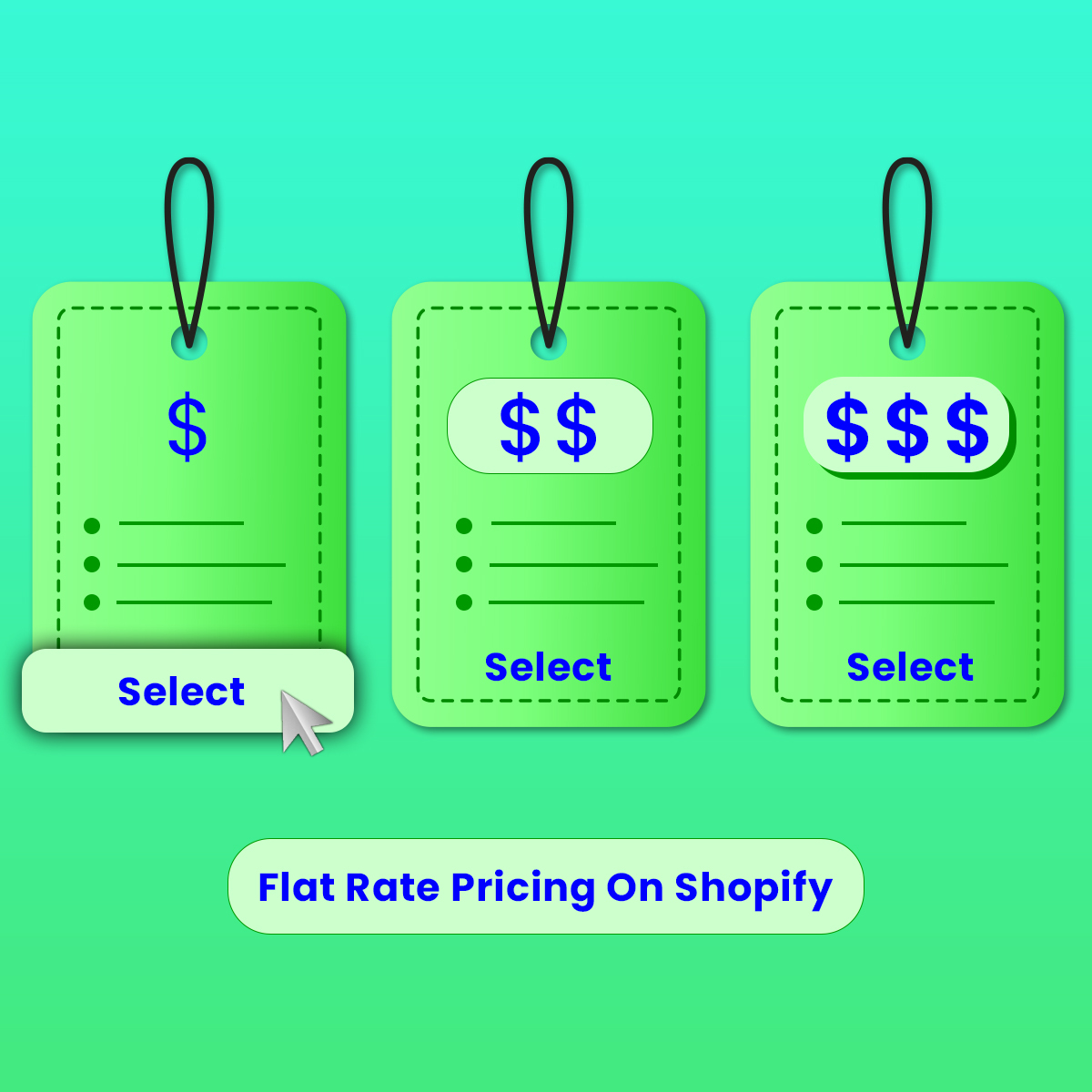Customers often abandon carts after encountering unexpectedly high shipping costs. This can significantly impact your sales. Flat rate pricing on Shopify offers a solution by simplifying the process and providing transparency.
Whether you’re new to Shopify or looking to improve your existing setup, understanding how to implement flat rate shipping is crucial. This guide will walk you through everything you need to know to effectively add flat rate shipping and pricing, enhance customer experience, and boost your store’s success.
What Is Flat Rate Pricing and Shipping?
Flat rate pricing and shipping refers to a predetermined cost you establish for your customers, regardless of the specific weight or destination of their order (within designated parameters).
Determining the Number for Flat Rates:
The optimal number of flat rates for your store depends on several factors, and may require experimentation to achieve the most optimized delivery costs. Here are some key considerations:
- Domestic vs. International Shipping: You may choose to offer separate flat rates for domestic and international shipments due to inherent cost differences.
- Order Value: Implementing tiered flat rates based on order value can incentivize larger purchases. For instance, a lower flat rate might apply to orders exceeding a specific amount.
- Product Weight and Size: If your product range varies significantly in weight or size, you might consider offering flat rate tiers based on these categories.
Ultimately, the goal is to strike a balance between covering your shipping costs and offering competitive rates that entice customers to complete their purchases.
How Does Flat Rate Pricing on Shopify Help?
Flat rate pricing on shopify offers a significant advantage for online stores: it fosters trust and transparency with customers. Unlike variable rates that fluctuate based on weight and destination, flat rates present a clear and consistent shipping cost upfront. This predictability allows customers to manage their expectations and avoid the frustration of encountering unexpected fees at checkout.
- The Power of Transparency:
Studies reveal that unexpected shipping costs are the main reason behind shopping cart abandonment. Flat rates address this concern by communicating shipping costs clearly, either through a banner announcement or on your dedicated shipping policy page. This upfront communication minimizes surprises and builds trust with your customers.
- Encouraging Larger Orders:
Flat rate shipping can be a powerful tool to incentivize larger purchases. Consider offering free shipping for orders exceeding a specific cart total. This strategy encourages customers to add extra items, ultimately increasing your average order value.
- Enhanced Customer Experience:
Within Shopify, flat rates are conveniently linked to shipping speeds based on the chosen shipping class.This streamlined setup automatically generates delivery time estimates for customers during checkout. Clear visibility into how quickly their order will arrive can lead to improved conversion rates and increased sales.
How To Choose The Perfect Flat Rate Pricing Number?
The optimal flat rate for your online store hinges on a careful balance between customer experience and your bottom line. Factors like product type, your business location, and your target shipping destinations all play a role.
- Calculating Average Shipping Costs:
The best approach to establish your flat rate is to estimate your average shipping cost. This average can then serve as your baseline flat rate. It’s important to acknowledge that with individual orders, you might make a slight profit or incur a slight loss on shipping depending on the specific items and destination. The key is to achieve an overall balance where these margins even out.
- Estimating Costs:
To estimate your average shipping cost, you’ll need to gather information on the weights and dimensions of your products and packaging. Utilize online shipping calculators to obtain estimates for various shipping methods and destinations. Once you have compiled these estimates, calculate the average cost. For a more customer-friendly experience, consider rounding this average to a whole number. For instance, an average domestic shipping cost of $11.72 could be rounded up to a flat rate of $12.
- Adapting Your Strategy:
Remember, your initial flat rate may need to be adjusted over time as your business grows or during specific periods. For instance, you might implement a more attractive flat rate as a promotional strategy during peak shopping seasons like Black Friday or Cyber Monday. Ultimately, the goal is to establish a flat rate that aligns with your overall business strategy while considering potential fulfillment challenges.
Which Condition To Choose Flat Rate Pricing on Shopify From?
Your general flat rate shipping can be further enhanced by introducing weight-based and price-based conditions. These additional options provide greater flexibility in managing shipping costs.
- Weight-Based Flat Rates
This approach allows you to establish specific shipping costs based on the total weight of a customer’s order. Imagine you want to differentiate rates for orders below and above 5 kg. Using weight-based rates, you could set a flat rate of $7 for orders under 5 kg and $15 for orders exceeding 5 kg. During checkout, a customer with a 7 kg cart would only see the $15 shipping option displayed.
This strategy is particularly beneficial when your product line leans towards heavier items, preventing you from absorbing significant shipping costs for bulky packages.
- Price-Based Flat Rates
Price-based flat rates enable you to set shipping costs based on a customer’s total order value. For example, you might want to offer different rates for orders below and above $50. With price-based rates, you could establish a flat rate of $4 for orders under $50 and $10 for orders exceeding $50.
This approach can incentivize customers to add more products to their cart to unlock the lower shipping option. While it may translate to absorbing a larger portion of the shipping cost on your end, the potential increase in average order value can justify the strategy.
How To Setup Flat Rate Pricing On Shopify?
Here’s a step-by-step guide on how to add flat rate shipping to your Shopify store:
1. Access Shipping Settings:
- Begin by logging into your Shopify admin panel.
- From the main menu, navigate to the “Settings” section.
- Within Settings, locate and click on “Shipping and delivery.”
2. Manage Shipping Rates:
- On the “Shipping and delivery” page, identify the shipping profile you wish to modify. This profile determines which products the shipping rates apply to.
- Locate the “Manage rates” option next to the chosen shipping profile and click on it.
3. Define Your Shipping Zone:
- The “Manage rates” section allows you to set shipping rates for different zones. These zones represent geographic regions where you deliver your products.
- Select the specific zone where you want to introduce the new flat rate.
- Click on “Add rate” next to the chosen zone.
4. Set Rate Details:
- Provide a descriptive name for your flat rate (e.g., “Standard Flat Rate”).
- Enter the specific shipping cost you want to charge for this rate.
5. Optional: Apply Weight or Price Conditions (Advanced):
- Shopify offers the option to set weight-based or price-based conditions for your flat rate.
- If you don’t require these conditions, you can proceed to step 6.
- To add conditions, click on “Add conditions.”
- Choose whether you want to base the condition on the customer’s order weight or total order price.
- Depending on your selection, enter the minimum and maximum values for the chosen condition.
- For instance, if you select “Order weight,” you might set a minimum weight of 0 kg and a maximum weight of 5 kg. This would only apply the flat rate to orders weighing between 0 kg and 5 kg.
6. Save Your Changes:
- Once you’ve completed all the necessary steps, click “Save” to finalize the addition of your flat rate shipping option.
Conclusion
Not all shipping strategies work the same for every business, but flat rates pricing on shopify can be a great choice for many online stores. They make the checkout process simpler and faster, which can lead to happier customers who come back to shop with you again.
Shoppers today want things fast, affordable, and with no surprises. Flat rates hit all these marks. They let customers know the shipping cost right away, show how long it will likely take to get their order, and can even offer discounts on shipping for bigger orders. This can be a powerful way to boost sales and keep your business profitable at the same time. And with dedicated courier shipping apps available right now on shopify. It has never been this easy to check and compare prices to find the best shipping deals for you.
So with all that knowledge, take control of your shipping costs and give your customers a smoother checkout experience! Set up flat rates for your Shopify store now!
FAQ
What Is Flat Rate In Ecommerce?
Flat rate in ecommerce refers to a predetermined cost for shipment, regardless of the specific weight of an item within a designated weight range. This cost may vary depending on the designated shipping zones. In simpler terms, customers pay a set price for shipping based on their location and the weight range of their order.
How Do You Calculate Flat Rate Fees?
In straightforward terms, flat-rate pricing is a business strategy where a set fee is established for a service, irrespective of the time required to complete it. This approach offers clarity and consistency for both the seller and the customer.





